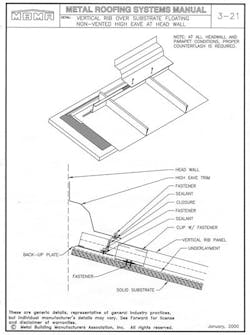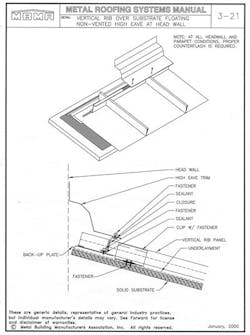Quick Fixes for Metal Roof Systems
The three previous columns in this series have sought out easy fixes for conventional membrane roofing systems. This month, we’ll look at metal roofing systems.
Repairing Metal RoofingSince metal roofing is produced from continuous coils, we can – with considerable confidence – state that the metal sheeting itself is not leaking. (The rare exception would be if the metal had rusted all the way through.) As a result of that far-reaching conclusion, we then immediately focus on the rest of the system (such as end- and side-laps, penetrations, and transitions).
Since there are two basic types of metal roofing: those that are expected to shed water (hydrokinetic) and those that resist standing water (hydrostatic), we need to address each separately. (See October 2002 and October 2003 Roofing News columns for more in-depth information).
In the shedding roof design, there will generally be a supporting deck underneath, as well as a secondary waterproofing system. The secondary system could be as simple as one layer of Type 15 asphalt-saturated roofing felt, or as complicated as a self-adhering Ice and Water Shield® membrane. The latter products are capable of sealing around fasteners, as well as self-sealing at their side- and end-laps. Where a secondary membrane has been used, obvious discontinuities in the metal panels above do not necessarily mean that’s where the leaks are. Hose-testing these discontinuities can verify whether these are the source of leaks or not. (Always hose-test starting at the eave of the roof and work upslope.) An excellent article on finding non-roof related leaks is by Dick Schroter, published in the May 2004 issue of RSI Magazine. Schroter showed how the use of temporary plastic sheeting could prove that the leaks were coming from somewhere upstream.
If the underlayment membrane is defective and is letting water enter the building envelope, repairs would require that the metal panels be removed and the membrane resealed. New penetrations in the roof panels, such as for HVAC equipment, conduit, etc., may prove to be the site of leakage, as the underlayment was penetrated and not sealed: There is no quick fix, as the metal panels are really not designed to keep water out.
Other causes of leakage, especially during cold weather, might be due to ice-damming. The back-up of water behind such a dam will cause leakage in unsealed underlays, such as shingled felts. The roofing industry recommends that a sealed eaves treatment be installed at least 3-feet inwards of the wall line of the building. Seeing icicles hanging down the outside wall is a good clue that there might be an ice-dam problem (and leakage just inside the building envelope also suggests this is the case). One fix might be to install heating cables along the eave; or, if there is an attic beneath the steep metal roof system, make sure the eaves are vented.
How About Those Big Holes?
Penetrations through standing seam metal roofs can be a significant source of leakage.
One reason for this: Most metal panel systems are designed to float, i.e. expand and contract with temperature change. If the roof is fixed at the eave, the panels will expand toward the ridge. That means any pipe or other vertical penetrations that go through the panel must be cut sufficiently oversized to let the panel slide up and down. The closer they are to the ridge, the greater the allowance must be for this movement. The correct treatment for these penetrations is the use of an elastomeric boot, specifically designed to cover the oversized hole. This is not the same as a plastic “jack” that might be used on a sloped, residential roof. The fix? Remove the improper boot, make sure the hole is larger than the pipe, and install the proper rubber roof jack. An excellent article with many illustrations of these conditions was recently published in the July/August 2004 issue of Metalmag.
The Metalmag article also illustrates that penetrations cannot effectively be sealed if they penetrate the raised seam of the panels. The fix: Move the penetration over a few inches so it is centered in the panel. Penetrations that cut through the seam may also compromise the structural performance of the roof panel.
Still another problem illustrated is the use of a stack penetration with a diameter so large that water flow is blocked. Water should never have to overflow a raised metal seam. The fix: Cut the upstream panels adjacent to the blocked panel, and install a welded curb with a diverter that channels the water around the stack to the adjacent panels. There are many firms that manufacture custom-made curbs with upstream crickets to divert water flow. The curb is produced to fit the specific configuration of the standing seams, so this information needs to be provided to the curb producer.
The reason that the hydrostatic panels move so much is that – unlike the steel deck on a conventional roof system – the thermal insulation is beneath the metal panel. This results in more thermal movement, since the panel gets colder in the winter (heat flow from the heated interior is retarded by the insulation) and hotter in the summer.
The movement could become a problem at both sidewalls and endwalls if carelessly designed and installed. A sidewall flashing cannot be rigidly fixed both to the moving metal panel and the stationary wall. This is usually handled by fixing a piece of flashing to the panel with an upturned vertical edge. This edge is counterflashed by a stationary piece of metal fixed to the wall, and the two can now slide past one another. At the endwall, the metal must be terminated short of the wall by whatever amount of expansion is anticipated: Usually, this is 1 inch or so. The end of each panel is upturned (common on hydrokinetic panels), or a separate flashing which mates with the seams provides an upturn. Where wind-driven rain or snow is of concern, a flexible membrane can be installed to create an air-barrier. The membrane is covered with an endwall-mounted counterflashing for foot protection and aesthetics. [See Figure 1, copied from the Metal Building Manufacturers Association’s (MBMA) Metal Roofing Systems Design Manual.] Quick fix – cut the panels short of the wall and install a system that accommodates the movement.
Quick Fixes?Some minor problems, such as deteriorated washers on panel fasteners, can be repaired by removing the bad fastener and installing a new one. There is a leak-tester that looks like a tire pump which can determine if a fastener is leaking air. If it is, the fastener replacement will work. It is a good idea to use an oversized washer, and to install some sealant under the washer before the fastener is placed. If the fastener is a screw and it has stripped out, then a larger-diameter screw or another type of fastener may be required. An alternative is to use a suitable, non-asphaltic mastic with woven mesh. Topically applied sealant does not provide long-term protection. Generally, this is done prior to recoating the entire metal roof, as the patches are pretty unsightly.
A more dramatic fix is to spray the entire metal panel roof with sprayed-in-place polyurethane foam. This is more common on unsightly, rusted corrugated panel roofs, where the foam’s rigidity can help stabilize the system. The foam is an efficient insulator, which means the panels will be moving less, and minor perforations or leaking fasteners will be bridged over and sealed. Foam systems require UV-resistant coatings that will need periodic resurfacing.
There have been cases where coatings applied to metal roofs have caused problems. If the coating is not waterproof, or if it has imperfections as a sealing membrane, water can get between the coating and the panel. This accelerates the corrosion of the panel while hiding what is happening. Over time, the panel could rust out since the owner is not able to detect that rust forming.Helpful Websites:Cool Metal Roofing CoalitionMetal Building Manufacturers Association
Metal Construction Association
Metal Roofing Alliance
National Roofing Contractors Association
Roof Coatings Manufacturers Association
Steel Roofing (GALVALUME®)
Spray Polyurethane Foam Alliance

